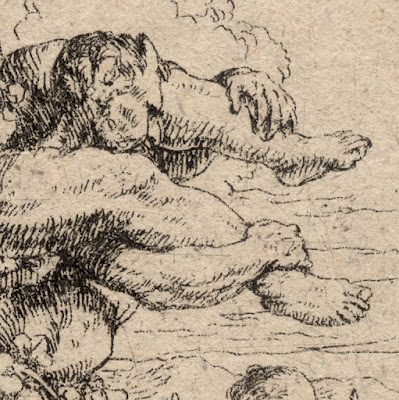Jonas Umbach (1624–93)
“The Drunken
Silenus Carried by Satyrs”, c.1660
Etching on fine
laid paper with margins and watermark (partial)
Size: (sheet) 11.3
x 15.7 cm; (plate) 8 x 12.2 cm
Signed in reverse
below upper margin at left: “Jonas Umbach f.”
The British
Museum offers the following description of this print:
“The drunken
Silenus carried by satyrs; to right; another satyr carrying a large vase.” (http://www.britishmuseum.org/research/collection_online/collection_object_details.aspx?objectId=1505128&partId=1&searchText=umbach+Silenus&page=1)
The
Metropolitan Museum of Art offers the following description of this print:
“Three satyrs
carrying the drunken Silenus, preceded by a putto carrying grapes; behind them
a satyr carrying a large vessel, a putto, and a bare-breasted woman” (http://metmuseum.org/art/collection/search/399687)
Nagler 128
Condition: marvellous
impression in near faultless condition. There is a collector’s stamp and pencil
notes (verso).
I am selling
this rare original etching by Jonas Umbach for AU$224 (currently US$168.24/EUR157.76/GBP136.93
at the time of this listing) including postage and handling to anywhere in the
world.
If you are
interested in purchasing this remarkable 17th century print by an artist famed
for his small etchings and for his skill in biting his printing plates only
once in acid, please contact me (oz_jim@printsandprinciples.com) and I will
send you a PayPal invoice to make the payment easy.
This print has been sold
This image of
the drunken Silenus—the wine-god Dionysus’ teacher and companion—is far from
unique. Even before Umbach executed it, the essential pictorial ingredients had
already been formalised by artists such as Peter Paul Rubens (1577–1640), Anthony
van Dyck (1599 –1641) and, to a lesser extent, Jusepe de Ribera (1591 –1652).
The earlier representations of this mythological figure invariably show Silenus
as a fat, bald, thick-lipped, squat-nosed, inebriated old man, supported by a
band of satyrs, putti and stray goddesses.
What makes this
particular scene special are the changes that Umbach made to the traditional
arrangement of the figures. Let me explain…
In Umbach’s
print the band of figures move to the right rather than to the left. Of course,
when Umbach originally drew the design onto the plate the figures would have been
moving to the left as is customary, but when the plate was printed the image is
in reversed—as is graphically illustrated by Umbach’s mirrored signature at the
top-left corner of the print. If I were to be asked what difference does this
have on the projected meaning of the image I would use the analogy of how old
movies were once edited: if the ending sequence was to show a happy outcome,
the train or galloping horse heads off into the distance towards the left;
whereas if the ending sequence expresses apprehension about an unknown future
the train or horse heads off into the distance towards the right.
Even the
arrangement of lighting is reversed, in that the direction of the light shown
in Umbach’s etching is from the top-front-right rather than the traditional
top-front-left. Again, if I were asked what difference does this make, I would
use the analogy of how we perceive the craters on the moon: if the craters are
lit from the top-front-left then the craters look like craters (i.e. concave
dents on the moon’s surface), but if they are lit from the opposite direction
the craters appear to be rounded mounds. In short, the figures portrayed in
Umbach’s scene present the mind with a conflict in how to read their forms.






No comments:
Post a Comment
Please let me know your thoughts, advice about inaccuracies (including typos) and additional information that you would like to add to any post.